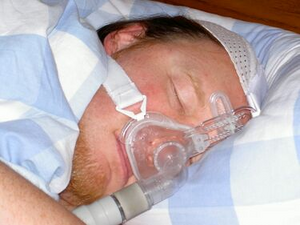ENT aspects of sleep apnea syndrome
Etiology and pathogenesis[edit | edit source]
- Pharyngeal obstruction – partial (ronchopathy) x complete (OSAS).
- The muscle tone is not enough to overcome the negative air pressure during inspiration and thus to maintain the lumen – the pharynx collapses; muscle tone decreases with age.
Other factors:
- the size of the velopharyngeal space (soft palate, uvula, tonsils, adenoid vegetation , tumors);
- the size of the retroglossal space (retroposition of the tongue, hypertrophy of the lingual tonsil);
- obstruction of the nasal cavity and nasopharynx.
The most common site of obstruction – soft palate, retroglossal space. Turbulent airflow through a partially collapsed larynx → vibration → snoring. Complete collapse of pharyngeal musculature → apnoeic pause (tens of seconds to minutes !!) → awakening reaction → restoration of muscle tone → restoration of breathing (often explosive snoring).
Consequences[edit | edit source]
Ronchopathy – mainly bothers the surroundings; OSAS – effect especially on KVS:
- CVD – hypertension , higher incidence of IM , CAD , arrhythmias, stroke.
- Disruption of sleep architecture - impact on quality of life - deterioration of cognitive functions, depression, sexual dysfunction, daytime sleepiness .
Diagnostics[edit | edit source]
- Benign rhonchopathy – without apnoeic pauses, without hypoventilation and hypoxia , the quality of sleep is not impaired.
- Syndrome of increased HCD resistance - increased respiratory effort → increased intrathoracic pressure → awakening, without hypoventilation and hypoxia.
- OSAS – apnoeic pauses (duration min. 10 s; more than 10 per hour); it is necessary to differentiate the central SAS (without HCD obstruction) .
Targeted anamnesis (if possible also from the partner); subjectively – insufficiently refreshing sleep, increased daytime sleepiness; habitus - often obesity; ENT examination – nasal patency, spaciousness of the velopharyngeal area and the area behind the root of the tongue, size of the mandible, position and size of the root of the tongue; possibly imaging methods – lateral X-ray cephalometry, CT, MR; examination in the sleep laboratory - all-night polysomnographic monitoring (distinguishing simple rhonchopathy from SAS and obstructive apnoeic pauses from central ones).
Therapy[edit | edit source]
- Conservative
- Lifestyle – sleep hygiene (regularity, adequate length), do not consume alcohol in the evening, avoid hypnotics, do not sleep on your back, do not smoke, weight reduction for obese people.
- CPAP (continuous positive airway pressure) – nasal positive pressure ventilation; the nasal mask - excess pressure in the HCD - prevents the collapse of the pharyngeal muscles.
- Surgery
- Nose and nasopharynx – septoplasty, adenotomy.
- Velopharyngeal space
- UPPP (uvulopalatopharynphoplasty) – resection of part of the soft palate, part of the palatal arches and the entire uvula, bilateral tonsillectomy.
- LAUP (laser assisted uvuloplasty) – laser uvuloplasty, outpatient procedure.
- Radiofrequency ablation – insertion of needles into tissue → delivery of radiofrequency energy → thermal damage → coagulation necrosis → a scar that is smaller in volume than the original tissue.
- Tongue retroposition, maxillomandibular shift, tracheostomy .
- Simple rhonchopathy – LAUP, radiofrequency ablation.
- Light to medium SAS – UPPP.
- Severe SAS – CPAP, UPPP (if CPAP is not possible).
Links[edit | edit source]
Related Articles[edit | edit source]
References[edit | edit source]
- KLOZAR, Jan, et al. Speciální otorinolaryngologie. 1. edition. Praha : Galén, 2005. 224 pp. ISBN 80-7262-346-X.

